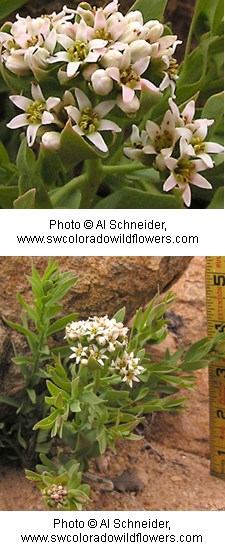
Comandra umbellata Family: Santalaceae – Sandalwood Family This is the only species from this family represented at Arches National Park. 3.1” to 1.1' (0.8 to 3.4 decimeters) tall; Perennial parasitic herbs Leaves: alternate; simple; entire; 0.4” to 1.3” (1 to 3.3 cm) long; 0.04” to 0.4” (1 to 10 mm) wide Flowers: 0 petals, 5 whitish green sepals; sepals come to a point, lance-shaped leaves; stamens as many as the sepals and opposite them; 1 pistil; flowers perfect; at least some flowers are borne in corymbs Pollinators: long-tongued bees, short-tongued bees, Diptera (flies), Lepidoptera (butterflies and moths), and Coleoptera (beetles) Fruits: drupe Blooms in Arches National Park: March, April, May, June Habitat in Arches National Park: desert shrub, grassland and pinyon-juniper communities Location seen: Park Avenue trail, park road between mile 0 and 1 on switchbacks just past Visitor Center Other: The genus name, “Comandra”, is from the Greek “kome” which means “hair” and “andros” which means “man” because the stamens are hairy at their base. The species name, “umbellata”, means “umbel-like” and refers to the flat-topped flower clusters. Bastard means false or of unusual shape or size, so sometimes Comandra umbellata is also called False toadflax. This plant is known to parasitize over 200 plant species and is also an alternate host for hard pine rust disease. It can reproduce sexually and also by spreading vegetatively. A single clone can cover a very large area. |
Last updated: April 29, 2025
